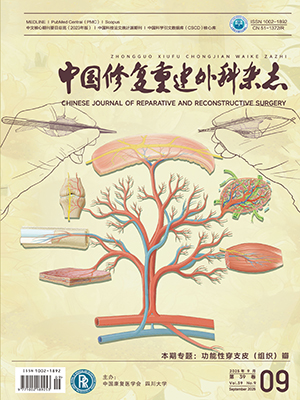| 1. |
陈佳丽, 白阳静, 宁宁. 护理人员下腰痛的影响因素研究进展. 护理学报, 2012, 19(7A): 13-16.
|
| 2. |
李男. 下腰痛患者肌肉力量和神经-肌肉活动研究现状. 体育科研, 2014, 35(2): 42-47.
|
| 3. |
安晶晶, 宁宁. 下腰痛的流行病学研究进展. 中国现代护理杂志, 2008, 14(27): 2934-2935.
|
| 4. |
Deyo RA, Weinstein JN. Low back pain. N Eng J Med, 2001, 344(5): 363-370.
|
| 5. |
Glanata KP, Wilson SE. Trunk posture and spinal stability. Clin Biomech, 2001, 16(8): 650-659.
|
| 6. |
Hägg GM. Interpretation of EMG spectral alternations and alternation indexes at sustained contraction. J Appl Physiol (1985), 1992, 73(4): 1211-1217.
|
| 7. |
王健, 金德闻. 康复医学领域的表面肌电应用研究. 中国康复理论与实践, 2006, 21(1): 6-7.
|
| 8. |
Laasonen EM. Atrophy of sacrospinal muscle groups in patients with chronic, diffusely radiating lumbar back pain. Neuroradiology, 1984, 26(1): 9-13.
|
| 9. |
Zhao WP, Kawaguchi Y, Matsui H, et al. Histochemistry and morphology of the multifidus muscle in lumbar disc herniation: comparative study between diseased and normal sides. Spine (Phila Pa 1976), 2000, 25(17): 2191-2199.
|
| 10. |
Solomonow M, Zhou B, Harris M, et al. Theligamento-muscular stabilizing system of the spine. Spine (Phila Pa 1976), 1988, 23(23): 2552-2662.
|
| 11. |
Kupa EJ, Roy SH, Kandarian SC, et al. Effects of muscle fiber type and size on EMG median frequency and conduction velocity. J Appl Physiol (1985), 1995, 79(1): 23-32.
|
| 12. |
Takahashi I, Kikuchi S, Sato K, et al. Effects of the mechanical load on forward bending motion of the trunk: comparison between pain and healthy subjects. Spine (Phila Pa 1976), 2007, 32(2): E73-78.
|
| 13. |
Oddsson LI, De Luca CJ. Activation imbalances in lumbarspine muscles in the presence of chronic low back pain. J Appl Pbysiol (1985), 2003, 94(4): 1410-1420.
|
| 14. |
Silfies SP, Squilante D, Maurer P, et al. Trunk muscle recruitment patterns in specificchronic low back pain populations. Clin Biomech (Bristol, Avon), 2005, 20(5): 465-473.
|
| 15. |
Wilder DG, Aleksiev AR, Magnusson ML, et al. Muscular response to sudden load. A tool to evaluate fatigue and rehabilitation. Spine (Phila Pa 1976), 1996, 21(22): 2628-2639.
|
| 16. |
刘邦忠, 李泽兵, 何萍. 多裂肌在脊柱突然失平衡时的肌电表现. 中国临床康复, 2003, 7(4): 544-545.
|
| 17. |
Radebold A, Cholewicki J, Panjabi MM, et al. Muscleresponse pattern to sudden trunk loading in healthy individualsand in patients with chronic low back pain. Spine (Phila Pa 1976), 2000, 25(8): 947-954.
|
| 18. |
Floyd WF, Silver PH. Function of erectores spinal in flexion of the trunk. Lancet, 1951, 1(6647): 133-134.
|
| 19. |
Golding JS. Electromyography of the erector spinae in low back pain. Postgrad Med J, 1952, 28(321): 401-406.
|
| 20. |
Floyd WF, Silver PH. The function of the erectores spinae muscles in certain movements and postures in man. J Physiol, 1955, 129(1): 184-203.
|
| 21. |
Morin F, Portnoy H. Electromyographic study of postural muscles in various positions and movements. Am J Physiol, 1956, 186(1): 122-126.
|
| 22. |
Ambroz C, Scott A, Ambroz A, et al. Chronic low back pain assessment using surfaceelectromyography. J Occup Environ Med, 2000, 42(6): 660-669.
|
| 23. |
Paquet N, Malouin F, Richards CL. Hip-spine movement interaction and muscle activation patternsduring sagittal trunk movements in low back pain patients. Spine (Phila Pa 1976), 1994, 19(5): 596-603.
|
| 24. |
Shirado O, Ito T, Kaneda K, et al. Flexion-relaxation phenomenon in the back muscles: A comparativestudy between healthy subjects and patients with chronic low back pain. Am J Phys Med Rehabil, 1995, 74(2): 139-144.
|
| 25. |
Flor H, Furst M, Birbaumer N. Deficient discrimination of EMG levels and overestimation of perceived tension in chronic pain patients. Appl Psychophysiol Biofeedback, 1999, 24(1): 55-66.
|
| 26. |
Watson PJ, Booker CK, Main CJ, et al. Surface electromyography in the identification of chronic low back pain patients: the development of flexion relaxation ratio. Clin Biomech, 1997, 12(3): 165-171.
|
| 27. |
Sihvonen T, Huttunen M, Makkonen M, et al. Functional changes in back muscle activitycorrelate with pain intensity and prediction of low back pain during pregnancy. Arch Phys Med Rehabil, 1998, 79(10): 1210-1212.
|
| 28. |
Geisser ME, Haig AJ, Wallbom AS, et al. Pain-related fear, lumbar flexion, and dynamicEMG among persons with chronic musculoskeletal low back pain. Clin J Pain, 2004, 20(2): 61-69.
|
| 29. |
Mayer TG, Neblett R, Brede E, et al. The quantified lumbar flexion-relaxation phenomenon is a useful measurement of improvement in a functional restoration program. Spine (Phila Pa 1976), 2009, 34(22): 2458-2465.
|
| 30. |
Renkawitz T, Boluki D, Grifka J. The association oflow back pain neuromuscular imbalance, and trunk extensionstrength inathletes. Spine J, 2006, 6(6): 673-683.
|
| 31. |
Lu WW, Luke KD, Cheung KM, et al. Back muscle contraction patterns of patients with low back pain before and after rehabilitation treatment: an electromyograhic evaluation. J Spinal Disord, 2001, 14(4): 277-288.
|
| 32. |
乔杰. 理筋手法在非特异性下腰痛中椎旁肌力学效应研究. 北京: 中国中医科学院, 2014.
|
| 33. |
吕俊玲. 委中穴不同放血量治疗下腰痛的即刻疗效及对表面肌电影响的临床研究. 福州: 福建中医学院, 2008.
|
| 34. |
Giggins OM, Persson UM, Caulfield B. Biofeedback in rehabilitation. J Neuro Eng Rehabil, 2013, 10: 60.
|
| 35. |
Flor H, Birbaumer N. Comparison of the efficacy of electromyographic biofeedback, cognitive-behavioral therapy, and conservative medical interventions in the treatment of chronicmusculoskeletal pain. J Consult Clin Psychol, 1993, 61(4): 653-658.
|
| 36. |
Neblett R. Surface Electromyographic (SEMG) Biofeedback for Chronic Low Back Pain. Heathcare, 2016, 4(2). pii: E27.
|
| 37. |
Neblett R, Mayer TG, Brede E, et al. Correcting abnormal flexion-relaxation in chronic low back pain: Responsiveness to a new biofeedback training protocol. Clin J Pain, 2010, 26(5): 403-409.
|




